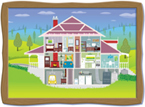
Cooling Tips
In the summer, home cooling typically accounts for up to half your energy costs. If your central air conditioning equipment is more than 12 years old, consider replacing it with ENERGY STAR® rated equipment -- before it breaks down -- to save money on utility bills, and ensure your family’s comfort. A high-efficiency air conditioner costs less to operate and its initial installation cost will be paid back many times during its lifetime.
Save money on the purchase price of qualified central air conditioner unit For more information, visit www.energystar.gov.
Save Energy
Reduce your energy use and save money by following these tips:
- Don’t turn your air conditioning off when you leave the house. Heat build-up in the walls and furniture makes it harder for your system to remove the heat when you return. Instead, set the temperature up five to ten degrees, but not off.
- Set your thermostat as high as comfortably possible in the summer. Only use your air conditioner when the temperature is above 78 degrees Fahrenheit.
- Use ceiling fans to provide additional cooling and better air circulation. Run the blades counter-clockwise (downward) to cool more efficiently. Ceiling fans cool only people, not the room so remember to turn ceiling fans off when you leave the room.
- Use an exhaust fan to blow hot air out of your kitchen while cooking. You’ll save more in cooling costs than the electricity to run the fan.
- To avoid activities that add heat and humidity to your home during the hottest parts of the day, consider the following:
- Cook outside on the grill instead of using the oven whenever possible.
- Use your microwave or other countertop appliances in place of the oven.
- Postpone laundry and dishwashing until nighttime when the outside air is cooler.
- Let dishes air dry in the dishwasher rather than using the drying feature.
- Minimize the number of times that outside doors are opened and closed. Hot air from outside enters your home every time the doors open.
- Keep window coverings closed during the day to prevent heat gain from the sun.
- Replace incandescent bulbs with high efficiency compact fluorescent lights. They use 75 percent less energy, produce about 75 percent less heat, and provide the same amount of light.
- Plant shade trees to shade your home and block the heat from the sun. Shade your air conditioner, too. Direct sunshine on the heat exchanger decreases its efficiency. A well-placed tree or awning will shade and protect the unit.
- Keep shrubbery and flowers away from your central air conditioner’s outdoor heat exchanger. This restricts its ability to release warm air and lowers its efficiency.
Replacing Your Central Air Conditioner
Considering energy-efficient air conditioners is a great first step toward lowering your energy usage—and your bills! What should you keep in mind as you shop?
- Always select ENERGY STAR qualified equipment. Although upfront costs can be higher, the long-term savings difference is regained with lower energy usage. ENERGY STAR central air conditioners are the most efficient models on the market.
- The EnergyGuide label with a high SEER. The Seasonal Energy Efficiency Ratio, or SEER, measures the energy efficiency of central air conditioners. SEER ratings allow consumers to compare operating costs of various cooling systems. The higher the SEER rating the more efficient the air conditioner runs, lowering your energy use.
- Capacity that fits your needs. The capacity of a central air conditioning unit is an important factor to consider. A qualified heating and cooling contractor can make the necessary calculations for your home to recommend the proper size unit. Don’t assume the new unit should be exactly the same as your existing unit, which may not have been properly sized in the first place.
- Replacement coils. To maximize the efficiency of your new cooling system, replace both the indoor and the outdoor compressor coils when replacing an older central air conditioning unit, to ensure they’re properly matched for maximum efficiency, comfort and dependability.
- Purchase high efficiency. Purchase the highest efficiency cooling equipment that you can afford. Look for central air conditioners with a SEER rating of at least 14 and the ENERGY STAR label for optimum efficiency.
- Install a programmable thermostat. You can save energy on heating and cooling your home by turning your thermostat back 10 to 15 percent for 8 hours or more. A programmable thermostat sets the temperature according to a pre-set schedule. When shopping for a programmable thermostat, look for the ENERGY STAR label and select a model that offers a manual override option that allows you to adjust the settings without affecting the rest of the pre-set programming.
- Proper installation is critical. Improper installation can lower efficiency by up to 30 percent, increase utility bills and possibly reduce the life of the equipment. Ask your contractor to verify that your system is properly charged with the correct level of refrigerant and that the airflow is within the manufacturer’s specifications.
Maintaining Your Central Air Conditioner
Keep your cooling system at peak performance by having your central air conditioner inspected annually before the cooling season begins. Call a local contractor to schedule an inspection in early spring.
Here are some tasks you may be able to perform yourself:
- Clean or replace the air filter regularly. Filters reduce the amount of dust and dirt that flow through your ductwork and into your home. Dirty filters can increase your energy costs and damage your equipment, leading to early failure.
- Follow manufacturers’ guidelines. For peak energy performance, always operate and maintain your heating system according to manufacturers’ guidelines.
- Check your outdoor condenser unit for dirt and debris. Remove leaves, grass and debris from the outside condenser monthly during warm months.
- Keep the outdoor air conditioning unit out of the sun. Locate your outdoor central air conditioning unit out of direct sunlight and avoid the south and west sides of the house, if possible. Placing the unit in direct sunlight causes it to work harder to cool your home.
- Clear and clean the drain line. Your central air conditioner system includes a tube that drains off any condensation. Check the drain periodically for any algae growth or blockage. If you see anything in the drain, remove the drain tube at the furnace and clean it by pouring a simple half bleach and half water solution through it.
Helpful Tools & Resources
courtesy of Energy Star
courtesy of Energy Star
- Guide to Energy Efficient Heating & Cooling
English (708KB)
(708KB)
Español (2.5MB)
(2.5MB) - Tips for Hiring a Heating and Cooling Contractor
- Duct Sealing brochure
 (1.13MB)
(1.13MB) - Maintenance Checklist

Cool Your World with ENERGY STAR @ home

Use the Home Energy Yardstick to
Measure Your Home's Performance

